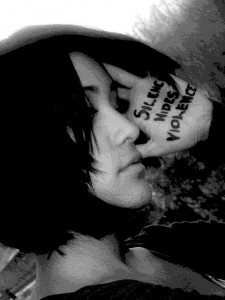Years ago we used to tell a joke:
What does PMS stand for?
No, not Pre-Menstrual Syndrome, so often derided by men,
but Putting up with Men’s Shit.

Domestic violence is a story as old as time, but for the first time in history women and men around the world are positioned to change the status quo.
Our 24/7 worldwide communication bequeaths a global plurality heretofore unknown. This new connectedness is finally exposing civilization’s dark love affair with sexual oppression and racism to more and more people. This new clarity enables graphic symbols, both good (Michael Brown) and bad (Ray Rice), borne wherever and whenever the message finally merges with the messenger, galvanizing mass communication and vital dialog among people of good will about important human rights issues.
Thanks to the National Football League’s now-finally-exposed sponsorship of wife-beaters, we are coming upon a new wave of feminist awareness and progress, even as we acknowledge that a quarter of domestic violence victims are men. This is not the time to go lightly, We have to use this hyper-visible opportunity to put an end this scourge, which has, in large part, worsened in direct proportion to the gains women have made.
Sexual oppression and racism are subject to the same action-reaction psychology. The end of slavery brought about Jim Crow. The civil rights advances of the 1960s eradicated Jim Crow laws but brought about the completely cynical southern state political strategy (inciting racial hatred in low-information white people in the south) and today’s shameful mass incarceration of brown and black men. While domestic violence has a very long history, the now prevalent use of birth control and professional child care, allowing unprecedented advancement of women at home and in business and politics, has enraged weak men who believe their masculinity is somehow threatened or diminished by when a woman, any woman, succeeds. A good man knows better.
The tireless efforts of individuals and organizations are finally taking center stage. Women and men are redoubling their efforts to reverse the very bad statistics appended to this post. The march of civilization’s progress is dependent on ending both the violent and more subtle forms of sexual repression, at home, in the workplace, and in the halls of political power.
There is much work to do in order to achieve social and economic justice, the end to sexual oppression, racism, income inequality, immigration restrictions, environmental degradation, etc. There are numerous organizations (for example, here, here, here) working on eradicating domestic violence that will welcome your advocacy, now more than ever before. But all individuals can start today by speaking out more vocally against domestic violence, and the unfair treatment of women in the workplace, by politicians, and in the society-at-large.
Educate yourself and keep these statistics handy when arguing the case with people, especially politicians and bosses. They are sobering.
- Every 9 seconds in the US a woman is assaulted or beaten.
- Around the world, at least one in every three women has been beaten, coerced into sex or otherwise abused during her lifetime. Most often, the abuser is a member of her own family.
- Domestic violence is the leading cause of injury to women—more than car accidents, muggings, and rapes combined.
- Studies suggest that up to 10 million children witness some form of domestic violence annually.
- Nearly 1 in 5 teenage girls who have been in a relationship said a boyfriend threatened violence or self-harm if presented with a breakup.
- Everyday in the US, more than three women are murdered by their husbands or boyfriends.
- Ninety-two percent of women surveyed listed reducing domestic violence and sexual assault as their top concern.
- Domestic violence victims lose nearly 8 million days of paid work per year in the US alone—the equivalent of 32,000 full-time jobs.
- Based on reports from 10 countries, between 55 percent and 95 percent of women who had been physically abused by their partners had never contacted non-governmental organizations, shelters, or the police for help.
- The costs of intimate partner violence in the US alone exceed $5.8 billion per year: $4.1 billion are for direct medical and health care services, while productivity losses account for nearly $1.8 billion.
- Men who as children witnessed their parents’ domestic violence were twice as likely to abuse their own wives than sons of nonviolent parents.
#####
